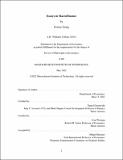Essays in MacroFinance
Author(s)
Gong, Feixue
DownloadThesis PDF (7.291Mb)
Advisor
Werning, Ivan
Greenwald, Daniel
Terms of use
Metadata
Show full item recordAbstract
I consider how debt structure affects asset prices and firm behavior.
In Chapter 1, I use a multi-state, general-equilibrium model with collateralized financial promises to study how allowing an asset to back multiple financial contracts (i.e., tranching) affects price bases.
A basis emerges when one asset can be tranched to issue more derivative securities than can be backed by another asset.
This theory correctly predicts that inclusion in the CDX index increases the underlying CDS basis.
In Chapter 2, I study the use of secured and unsecured debt by nonfinancial firms for financing. I find that firms with a higher fraction of their assets pledged respond more strongly to contractionary shocks but there is no difference in response to expansionary shocks. I then use a simple model to show that firms will endogenously arrive at these different levels of secured and unsecured debt due to differences in their expected future investment opportunities.
In Chapter 3, I use debt covenant violations to study resolution of defaults and firm behavior. I find that the way violations are resolved have substantial implications for firm behavior: resolutions that preserve the lenders' rights lead to lower investment and debt issuance. I also find that violation outcomes are not solely determined by borrower health. In particular, lenders have a lot of discretion when deciding how to resolve a violation. Harsh lenders punish violators both by sending them disproportionately into worse resolutions, and, conditional on the resolution received, firms with harsh lenders issue less debt and have lower investment. I also provide evidence that firms dealing with multiple lenders face significant coordination friction when trying to resolve violations, likely due to the presence of cross-default clauses.
Date issued
2022-05Department
Massachusetts Institute of Technology. Department of EconomicsPublisher
Massachusetts Institute of Technology